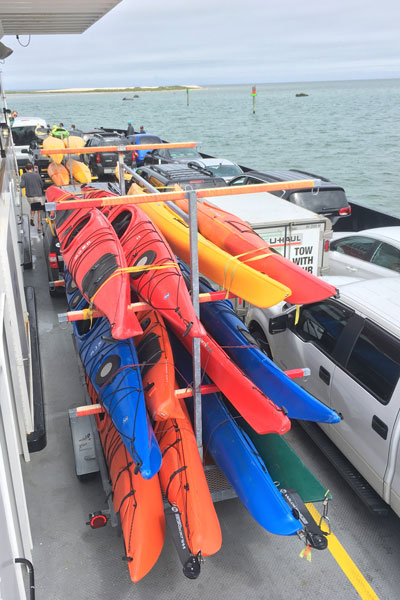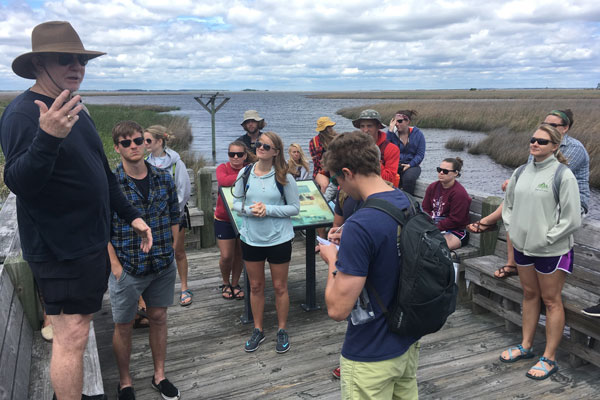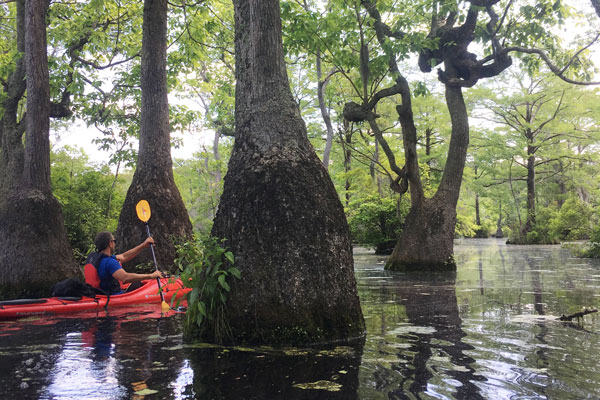
ABOVE: Students from the University of North Carolina at Wilmington camped on Bear Island on Hammocks Beach State Park as part of a class focused on coastal issues in the state. Photo by John Cannon.
The Value of Learning from the Field

With so many kayaks and vehicles, the class was always noticed wherever it went, even on the ferry from Hatteras to Ocracoke. Photo by Sarah Spiegler.
This spring, I spent two weeks traveling the North Carolina coast — from the Virginia border south to Wilmington — with 20 graduate and undergraduate students from the University of North Carolina Wilmington.
I was one of five co-instructors of the N.C. Coastal Issues and Experience, or NCCIE, class, where students learn about relevant coastal issues in North Carolina.
The convoy included a van, a trailer for camping gear, three kayak trailers, six SUVs, 25 kayaks and 25 people prepared to spend two weeks kayaking, camping in tents, and meeting with resource managers and coastal professionals while visiting over 20 national and state parks, and nonprofit organizations in North Carolina.
Needless to say, our group never arrived anywhere without being noticed.
We learned about various issues facing North Carolina’s coast, including shoreline erosion and protection, beach nourishment, sea-level rise and climate change, invasive species, saltwater intrusion, stormwater runoff, visitor impacts from tourism, human development, and community resiliency. The class met with over 15 coastal managers in 14 days. These managers were eager to share how they are improving the lives of those living and working at our coast.
James Herstine, a UNCW professor and lead instructor, created this class 17 years ago. NCCIE is cross-listed at UNCW in the School of Health and Applied Sciences, Recreation, Sport Leadership and Tourism Management Program, the Coastal and Ocean Policy Program, and the Department of Environmental Studies. It is also part of the UNCW Experiential Transformational Education through Applied Learning (ETEAL) program.
Students complete a combination of in-class work and direct, hands-on experience on the coastal sounds, estuarine waters, wetlands and upland areas of North Carolina. They also learn about relevant coastal issues in the state, experience the resources they may one day be tasked with managing, gain professional skills, and become stronger critical thinkers. This knowledge benefits the students when applying for jobs upon graduation.

James Herstine, left, talks to the students at a stop on Currituck Banks Reserve. Photo by Sarah Spiegler.
Interacting with resource managers also enables the students to build their professional networks and to receive career advice. Several managers noted that job applicants who have taken this class usually are viewed favorably because of the skills gained.
Many of Herstine’s former students from this class are working in resource management around the state, including Jennifer Cox, a park ranger at Jockey’s Ridge State Park. Ranger Cox had our class debate — from the perspective of various stakeholders — pros and cons of management issues such as drone usage in parks, sand removal and visitor access to beach areas, and private concessionaires operating in public parks .
In my day-to-day job, I am the outreach specialist for the N.C. Sentinel Site Cooperative. I work with people from various academic institutions, and state and federal coastal-management agencies to address sea-level rise, climate change and coastal-resiliency challenges in Eastern North Carolina. During this class, I asked the students to think critically about how community vulnerability to coastal hazards such as sea-level rise are affected by the complex connections between the natural resources, history, culture and economy of the places we visited.
Two main points were impressed upon the students consistently throughout this two-week class. First, there are many grey areas in coastal issues, and there is usually no easy answer or solution. Second, managing people often is the most challenging aspect of many resource managers’ responsibilities.

From their kayaks, students got a close look at swamps in Merchant’s Millpond State Park. Photo by Sarah Spiegler
As Jeff Turner, park ranger at Merchant’s Millpond State Park, explained, “Managing nature is easy. People, on the other hand, do a lot of things that don’t make sense.”
Cindy Heffley, visitor services specialist at the Alligator River National Wildlife Refuge Visitors Center, noted: “Even if you are a scientist, at some point you will have to work with people.”
The enthusiasm of the students enrolled in this class was readily apparent. They asked difficult questions about how to protect valuable coastal resources. They were passionate about engaging in the process to create a better world for future generations. It was not uncommon for the conversations throughout the day to focus on coastal-management issues.
These discussions took place during car rides, on the kayaks, during presentations by resource managers, during meal times, and when hanging out around the campfire at the nightly camping spot.
The students and professionals I met along the way during this class give me cause for optimism. I witnessed passionate people working to protect our North Carolina coast for future generations.
Sarah Spiegler is the outreach specialist for the N.C. Sentinel Site Cooperative. She has a background in coastal environmental management, and has worked with organizations in Massachusetts, Florida, Ohio and Louisiana. She holds a Master’s of Environmental Management from Duke University. Spiegler also is an American Canoe Association kayak and stand up paddleboard instructor.